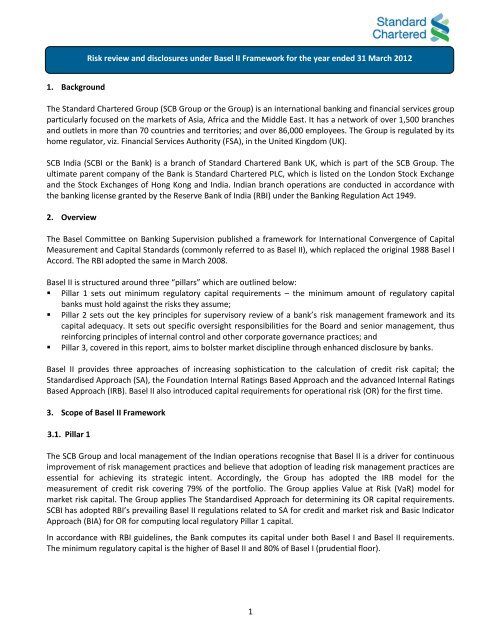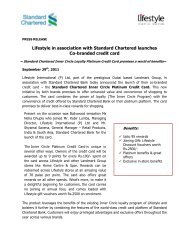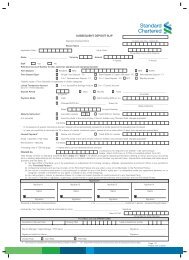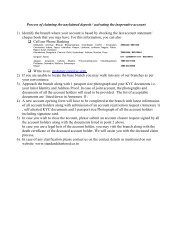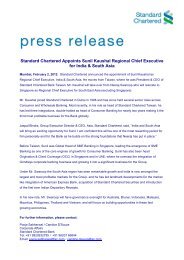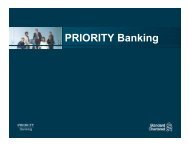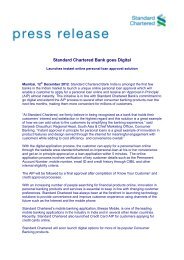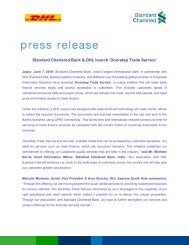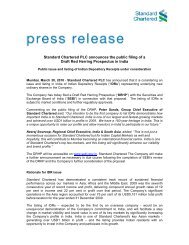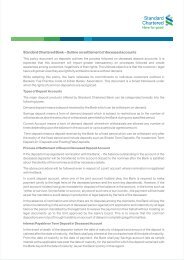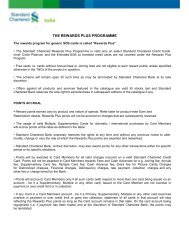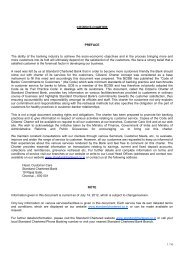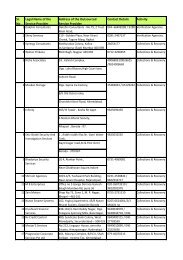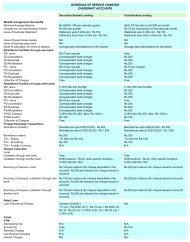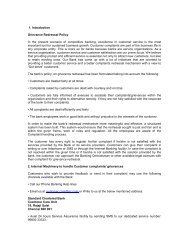March 12 - Standard Chartered Bank
March 12 - Standard Chartered Bank
March 12 - Standard Chartered Bank
Create successful ePaper yourself
Turn your PDF publications into a flip-book with our unique Google optimized e-Paper software.
Risk review and disclosures under Basel II Framework for the year ended 31 <strong>March</strong> 20<strong>12</strong><br />
1. Background<br />
The <strong>Standard</strong> <strong>Chartered</strong> Group (SCB Group or the Group) is an international banking and financial services group<br />
particularly focused on the markets of Asia, Africa and the Middle East. It has a network of over 1,500 branches<br />
and outlets in more than 70 countries and territories; and over 86,000 employees. The Group is regulated by its<br />
home regulator, viz. Financial Services Authority (FSA), in the United Kingdom (UK).<br />
SCB India (SCBI or the <strong>Bank</strong>) is a branch of <strong>Standard</strong> <strong>Chartered</strong> <strong>Bank</strong> UK, which is part of the SCB Group. The<br />
ultimate parent company of the <strong>Bank</strong> is <strong>Standard</strong> <strong>Chartered</strong> PLC, which is listed on the London Stock Exchange<br />
and the Stock Exchanges of Hong Kong and India. Indian branch operations are conducted in accordance with<br />
the banking license granted by the Reserve <strong>Bank</strong> of India (RBI) under the <strong>Bank</strong>ing Regulation Act 1949.<br />
2. Overview<br />
The Basel Committee on <strong>Bank</strong>ing Supervision published a framework for International Convergence of Capital<br />
Measurement and Capital <strong>Standard</strong>s (commonly referred to as Basel II), which replaced the original 1988 Basel I<br />
Accord. The RBI adopted the same in <strong>March</strong> 2008.<br />
Basel II is structured around three “pillars” which are outlined below:<br />
• Pillar 1 sets out minimum regulatory capital requirements – the minimum amount of regulatory capital<br />
banks must hold against the risks they assume;<br />
• Pillar 2 sets out the key principles for supervisory review of a bank’s risk management framework and its<br />
capital adequacy. It sets out specific oversight responsibilities for the Board and senior management, thus<br />
reinforcing principles of internal control and other corporate governance practices; and<br />
• Pillar 3, covered in this report, aims to bolster market discipline through enhanced disclosure by banks.<br />
Basel II provides three approaches of increasing sophistication to the calculation of credit risk capital; the<br />
<strong>Standard</strong>ised Approach (SA), the Foundation Internal Ratings Based Approach and the advanced Internal Ratings<br />
Based Approach (IRB). Basel II also introduced capital requirements for operational risk (OR) for the first time.<br />
3. Scope of Basel II Framework<br />
3.1. Pillar 1<br />
The SCB Group and local management of the Indian operations recognise that Basel II is a driver for continuous<br />
improvement of risk management practices and believe that adoption of leading risk management practices are<br />
essential for achieving its strategic intent. Accordingly, the Group has adopted the IRB model for the<br />
measurement of credit risk covering 79% of the portfolio. The Group applies Value at Risk (VaR) model for<br />
market risk capital. The Group applies The <strong>Standard</strong>ised Approach for determining its OR capital requirements.<br />
SCBI has adopted RBI’s prevailing Basel II regulations related to SA for credit and market risk and Basic Indicator<br />
Approach (BIA) for OR for computing local regulatory Pillar 1 capital.<br />
In accordance with RBI guidelines, the <strong>Bank</strong> computes its capital under both Basel I and Basel II requirements.<br />
The minimum regulatory capital is the higher of Basel II and 80% of Basel I (prudential floor).<br />
1
Risk review and disclosures under Basel II Framework for the year ended 31 <strong>March</strong> 20<strong>12</strong><br />
3.2. Pillar 2<br />
Pillar 2 requires banks to undertake a comprehensive assessment of their risks and to determine the appropriate<br />
amounts of capital to be held against these risks where other suitable mitigants are not available. This risk and<br />
capital assessment is commonly referred to as an Internal Capital Adequacy Assessment Process (ICAAP). The<br />
range of risks that need to be covered by the ICAAP is much broader than Pillar 1, which covers only credit risk,<br />
market risk and OR.<br />
The Group has developed an ICAAP framework which closely integrates the risk and capital assessment<br />
processes and ensures that adequate levels of capital are maintained to support the current and projected<br />
demand for capital under expected and stressed conditions. The ICAAP framework has been designed to be<br />
applied consistently across the organisation to meet the Pillar 2 requirements of local regulators. As a branch of<br />
a foreign bank in India, the India ICAAP is largely based on the Group ICAAP framework, so as to maintain<br />
consistency in reporting of the risk and capital management aspects. However, wherever necessary, local<br />
customisation has been incorporated to align with the RBI requirements as well.<br />
3.3. Pillar 3<br />
Pillar 3 aims to provide a consistent and comprehensive disclosure framework that enhances comparability<br />
between banks and further promotes improvements in risk management practices. The <strong>Bank</strong> has implemented<br />
the requirements laid down by RBI for Pillar 3 disclosure, covering both the qualitative and quantitative items.<br />
These are also published in the <strong>Bank</strong>’s annual report and hosted on the <strong>Bank</strong>’s website.<br />
The risk related disclosures and analysis provided herein below, are primarily in the context of the disclosures<br />
required under the RBI’s Pillar 3 – Market Discipline of the New Capital Adequacy Framework (commonly<br />
referred to as NCAF) and are in respect of SCBI, except where required and specifically elaborated, to include<br />
other Group entities operating in India. The information provided has been reviewed by senior management and<br />
is in accordance with the guidelines prescribed by the RBI.<br />
3.4. Accounting and Prudential Treatment / Consolidation Framework<br />
The consolidation norms for accounting are determined by the prevailing Indian Generally Accepted Accounting<br />
Principles (GAAP) viz. AS 21 Consolidated Financial Statements and AS 27 Financial Reporting of Interests in Joint<br />
Ventures. The regulatory requirements are governed by circulars and guidelines of the RBI. The differences<br />
between consolidation for accounting purposes and regulatory purposes are mainly on account of following<br />
reasons:<br />
1) Control over other entities to govern the financial and operating policies of the subsidiaries or joint<br />
ventures<br />
As per Indian GAAP, existence of control/joint control to govern the financial and operating policies of<br />
the subsidiary or joint venture is necessary for accounting consolidation. However, certain entities such<br />
as Non <strong>Bank</strong>ing Finance Companies (NBFC) have to be consolidated for regulatory capital adequacy<br />
purposes even where the above requirement is not fulfilled. Such cases are where the ability to control<br />
financial and operating policies of the entities legally vests with the Parent or Group entities and not with<br />
the India branch operations.<br />
2
Risk review and disclosures under Basel II Framework for the year ended 31 <strong>March</strong> 20<strong>12</strong><br />
2) Nature of business of the entities to be consolidated<br />
As per Indian GAAP, subsidiaries are not excluded from consolidation because of dissimilar nature of<br />
business activities between subsidiary and other entities within the Group. However, RBI regulations do<br />
not require consolidation of entities engaged in insurance business and businesses not pertaining to<br />
financial services.<br />
3) Method of consolidation<br />
The accounting consolidation methodology requires ‘line by line’ consolidation and elimination of all<br />
inter-group balances. However, for the purpose of regulatory consolidation under the capital adequacy<br />
framework, the risk weighted assets (RWA) and capital requirements for each entity can be computed<br />
separately by applying the Basel II norms as applicable for a bank and simply added together with that of<br />
the lead bank in the consolidated group. The <strong>Bank</strong> has adopted the latter approach for consolidation of<br />
entities for limited purpose of capital adequacy framework, as the accounting consolidation method is<br />
not appropriate considering the legal ownership pattern of the consolidated entities.<br />
Details of the entities consolidated for regulatory purposes is summarised below:<br />
Name of the<br />
entity<br />
<strong>Standard</strong><br />
<strong>Chartered</strong> <strong>Bank</strong><br />
India Branches<br />
Status for<br />
regulatory<br />
purposes<br />
Licensed bank in<br />
India<br />
Nature of business Description of the entity Type of<br />
consolidation<br />
<strong>Bank</strong>ing and financial services<br />
Branch operation of foreign<br />
bank viz. SCB, UK<br />
Full<br />
St. Helens<br />
Nominees India<br />
Pvt. Limited<br />
Fully owned<br />
subsidiary of<br />
licensed bank<br />
Nominee business - holding<br />
shares/debentures in limited<br />
companies on behalf of SCBI<br />
and its customers. Security<br />
trusteeship business for SCBI.<br />
Private Limited Company<br />
incorporated under Indian<br />
Companies Act<br />
Full<br />
<strong>Standard</strong><br />
<strong>Chartered</strong><br />
Investments<br />
and Loans India<br />
Limited<br />
Entity controlled<br />
by licensed<br />
bank’s<br />
Parent/Group<br />
Financial services acceptable<br />
for an NBFC, other than<br />
accepting public deposits, e.g.<br />
lending, investments, etc.<br />
a) Private Limited<br />
Company incorporated<br />
under Indian Companies<br />
Act<br />
b) NBFC registered with RBI<br />
and categorised as non<br />
deposit taking<br />
systemically important<br />
NBFC<br />
Full<br />
<strong>Standard</strong><br />
<strong>Chartered</strong><br />
Securities<br />
(India) Limited<br />
Entity controlled<br />
by licensed<br />
bank’s<br />
Parent/Group<br />
Category I merchant banker,<br />
rendering broking services to<br />
retail and institutional<br />
customers and depository<br />
services<br />
Limited Company<br />
incorporated under Indian<br />
Companies Act<br />
Full<br />
3
Risk review and disclosures under Basel II Framework for the year ended 31 <strong>March</strong> 20<strong>12</strong><br />
Quantitative Disclosures<br />
The aggregate amount of capital deficiencies in all subsidiaries not included in the consolidation,<br />
i.e., that are deducted and the name(s) of such subsidiaries.<br />
The aggregate amounts (e.g., current book value) of the bank’s total interests in insurance<br />
entities, which are risk-weighted, as well as, their name, their country of incorporation or<br />
residence, the proportion of ownership interest and, if different, the proportion of voting power<br />
in these entities. In addition, indicate the quantitative impact on regulatory capital of using this<br />
method versus using the deduction.<br />
NIL<br />
NIL<br />
4. Capital Management<br />
4.1. Objectives<br />
The <strong>Bank</strong>’s approach to capital management is driven by its desire to maintain a strong capital base to support<br />
the development of its business and meet regulatory capital requirements at all times.<br />
4.2. Approach<br />
Strategic, business and capital plans are drawn up annually covering a five year horizon. The plans ensure that<br />
adequate levels of capital and an optimum mix are maintained by the <strong>Bank</strong> to support its strategy. This is<br />
integrated with the <strong>Bank</strong>’s annual planning process which takes into consideration business growth<br />
assumptions across products and the related impact on capital resources.<br />
The capital plan takes the following into account:<br />
• Regulatory capital requirements;<br />
• Demand for capital due to business growth, market stresses and potential risks; and<br />
• Available supply of capital and capital raising options.<br />
The Group uses internal models and other quantitative techniques in its internal risk and capital assessment at<br />
an overall Group level. The <strong>Bank</strong> also considers additional risk types other than those considered under Pillar 1<br />
as part of its ICAAP. Each material risk is assessed, relevant mitigants considered, and appropriate levels of<br />
capital determined.<br />
Stress testing and scenario/sensitivity analysis are used to assess the <strong>Bank</strong>’s ability to sustain operations during<br />
periods of extreme but plausible events. They provide an insight into the potential impact of significant adverse<br />
events on the <strong>Bank</strong>’s earnings, risk profile and capital position and how these could be mitigated.<br />
The capital that the <strong>Bank</strong> is required to hold by the RBI is mainly determined by its balance sheet, off-balance<br />
sheet and market risk positions, after applying collateral and other risk mitigants.<br />
4.3. Governance<br />
The Group operates processes and controls to monitor and manage capital adequacy across the organisation. At<br />
a country level, capital is maintained on the basis of the local regulator’s requirements. It is overseen by the<br />
country Asset and Liability Committee (ALCO), which is responsible for managing the country balance sheet,<br />
capital and liquidity, with the active support and guidance from Group ALCO (GALCO), Group Capital<br />
4
Risk review and disclosures under Basel II Framework for the year ended 31 <strong>March</strong> 20<strong>12</strong><br />
Management Committee (GCMC) and Group Treasury (GT). The responsibility of capital management has been<br />
assigned to a dedicated sub-group of ALCO, the Capital Management Group (CMG), which meets at least once a<br />
month.<br />
Suitable processes and controls are in place to monitor and manage capital adequacy and ensure compliance<br />
with local regulatory ratios in all legal entities. These processes are designed to ensure that each entity and the<br />
consolidated <strong>Bank</strong> has sufficient capital available to meet local regulatory capital requirements at all times.<br />
4.4. Mobility of Capital Resources<br />
The <strong>Bank</strong> operates as a branch in India, hence under current RBI regulations it cannot raise capital externally.<br />
The Group’s policy in respect of profit repatriation requires that each local entity should remit its profits that are<br />
considered surplus to local regulatory minimum requirements. The amount to be remitted/injected and the<br />
mix/mode of capital (Tier 1 v/s Tier 2) is determined in conjunction with GT, after taking into account local<br />
capital adequacy regulations and other relevant factors.<br />
4.5. Capital Structure<br />
Tier 1 capital mainly comprises of:<br />
i) Capital funds injected by Head Office (HO).<br />
ii) Net profits of each year retained as per statutory norms (currently 25%).<br />
iii) Remittable net profits retained in India for meeting minimum regulatory capital requirements.<br />
iv) Capital reserves created out of profits on account of sale of immovable properties / held to maturity<br />
investments, as per RBI regulations.<br />
These above are not repatriable/distributable to HO as long as the <strong>Bank</strong> operates in India. Also, no interest is<br />
payable on the same.<br />
Tier 2 capital mainly comprises of:<br />
i) 45% of reserve created on periodic revaluation of immovable properties in accordance with the Indian<br />
GAAP.<br />
ii) General provisions on standard (performing) assets created as per RBI regulations.<br />
iii) Reserve created out of unrealised gain on revaluation of investments as per RBI regulations.<br />
iv) Subordinated debts from HO in foreign currency. These are unsecured, unguaranteed and subordinated to<br />
the claims of other creditors, including without limitation, customer deposits and deposits by banks. Refer<br />
note 18(E)(4)(ii) of the financial statements for details of outstanding subordinated debts.<br />
As per RBI regulations, Tier 2 capital cannot exceed 100% of Tier 1, subordinated debts cannot exceed 50% of<br />
Tier 1 and general provisions qualifying as Tier 2 is restricted to 1.25% of RWA.<br />
5
Risk review and disclosures under Basel II Framework for the year ended 31 <strong>March</strong> 20<strong>12</strong><br />
4.6. Capital and RWA<br />
31.3.20<strong>12</strong><br />
Solo <strong>Bank</strong>*<br />
(Rs. in 000s)<br />
Consolidated<br />
Basis*<br />
Basel II Basel I Basel II<br />
Tier 1 Capital : 102,082,696 102,449,575 107,767,442<br />
Head Office capital 6,757,992 6,757,992 6,757,992<br />
Paid-up capital of subsidiaries / associates - - 5,075,257<br />
Eligible reserves 110,843,234 110,843,234 1<strong>12</strong>,089,270<br />
Intangible assets (13,562,380) (13,562,380) (14,197,315)<br />
Unconsolidated subsidiaries / associates (50) (50) (50)<br />
Other regulatory adjustments (1,956,100) (1,589,221) (1,957,7<strong>12</strong>)<br />
Tier 2 Capital : 35,626,405 35,993,285 35,637,302<br />
Eligible revaluation reserves 4,790,992 4,790,992 4,790,992<br />
General provision and other eligible reserves/provisions 6,432,392 6,432,392 6,444,900<br />
Debt capital instruments eligible to be reckoned as capital funds<br />
and included in Lower Tier 2 (of which amount raised during the<br />
year Rs. Nil) 25,437,500 25,437,500 25,437,500<br />
Less: Amortisation of qualifying subordinated debts - - -<br />
Other regulatory adjustments (1,034,479) (667,599) (1,036,090)<br />
Total Capital Base 137,709,101 138,442,860 143,404,744<br />
Minimum Regulatory Capital Requirements<br />
Credit Risk 96,136,043 89,113,873 96,775,462<br />
<strong>Standard</strong>ised approach portfolios 76,007,<strong>12</strong>5 - 76,646,544<br />
Securitisation exposures - - -<br />
Counterparty Risk on FX and Derivatives 20,<strong>12</strong>8,918 - 20,<strong>12</strong>8,918<br />
Market Risk - <strong>Standard</strong>ised Duration Approach 6,275,521 8,182,983 6,278,859<br />
Interest rate risk 5,887,134 7,794,597 5,887,134<br />
Foreign exchange risk (including gold) 360,000 360,000 360,000<br />
Equity Risk 28,387 28,386 31,725<br />
Operational Risk – Basic Indicator Approach 9,705,684 - 9,894,048<br />
Total Minimum Regulatory Capital Requirements 1<strong>12</strong>,117,248 97,296,856 1<strong>12</strong>,948,369<br />
Risk Weighted Assets and Contingents :<br />
Credit Risk 1,068,178,257 990,154,145 1,075,282,901<br />
Market Risk 69,728,0<strong>12</strong> 90,922,038 69,765,101<br />
Operational Risk – Basic Indicator Approach 107,840,933 - 109,933,855<br />
Total Risk Weighted Assets and Contingents 1,245,747,202 1,081,076,183 1,254,981,857<br />
Capital Ratios<br />
Tier 1 Capital 8.19% 9.48% 8.59%<br />
Tier 2 Capital 2.86% 3.33% 2.84%<br />
Total Capital 11.05% <strong>12</strong>.81% 11.43%<br />
6
Risk review and disclosures under Basel II Framework for the year ended 31 <strong>March</strong> 20<strong>12</strong><br />
31.3.2011<br />
Solo <strong>Bank</strong>*<br />
(Rs. in 000s)<br />
Consolidated<br />
Basis*<br />
Basel II Basel I Basel II<br />
Tier 1 Capital : 94,875,451 95,1<strong>12</strong>,272 100,008,735<br />
Head Office capital 6,757,992 6,757,992 6,757,992<br />
Paid-up capital of subsidiaries / associates - - 4,954,257<br />
Eligible reserves 96,500,910 96,500,910 97,105,847<br />
Intangible assets (6,572,523) (6,572,523) (6,990,933)<br />
Unconsolidated subsidiaries / associates (50) (50) (50)<br />
Other regulatory adjustments (1,810,878) (1,574,057) (1,818,378)<br />
Tier 2 Capital : 31,763,949 32,000,770 31,775,055<br />
Eligible revaluation reserves 5,492,144 5,492,144 5,492,144<br />
General provision and other eligible reserves/provisions 5,016,161 5,016,161 5,027,267<br />
Debt capital instruments eligible to be reckoned as capital funds<br />
and included in Lower Tier 2 (of which amount raised during the<br />
year Rs. Nil) 22,297,500 22,297,500 22,297,500<br />
Less: Amortisation of qualifying subordinated debts - - -<br />
Other regulatory adjustments (1,041,856) (805,035) (1,041,856)<br />
Total Capital Base <strong>12</strong>6,639,400 <strong>12</strong>7,113,042 131,783,790<br />
Minimum Regulatory Capital Requirements<br />
Credit Risk 84,099,895 75,296,788 84,676,496<br />
<strong>Standard</strong>ised approach portfolios 67,131,734 - 67,708,335<br />
Securitisation exposures 8,742 - 8,742<br />
Counterparty Risk on FX and Derivatives 16,959,419 - 16,959,419<br />
Market Risk - <strong>Standard</strong>ised Duration Approach 2,797,700 3,718,467 2,808,087<br />
Interest rate risk 2,409,313 3,330,080 2,409,313<br />
Foreign exchange risk (including gold) 360,000 360,000 360,000<br />
Equity Risk 28,387 28,387 38,774<br />
Operational Risk – Basic Indicator Approach 9,033,741 - 9,263,439<br />
Total Minimum Regulatory Capital Requirements 95,931,336 79,015,255 96,748,022<br />
Risk Weighted Assets and Contingents :<br />
Credit Risk 934,443,284 836,630,978 940,849,953<br />
Market Risk 31,085,556 41,316,299 31,200,971<br />
Operational Risk – Basic Indicator Approach 100,374,903 - 102,927,099<br />
Total Risk Weighted Assets and Contingents 1,065,903,743 877,947,277 1,074,978,023<br />
Capital Ratios<br />
Tier 1 Capital 8.90% 10.83% 9.30%<br />
Tier 2 Capital 2.98% 3.65% 2.96%<br />
Total Capital 11.88% 14.48% <strong>12</strong>.26%<br />
* Solo bank represents the main licensed bank of the Group in India and consolidated basis includes Group<br />
controlled entities operating in India and consolidated for the limited purpose of capital adequacy framework.<br />
7
Risk review and disclosures under Basel II Framework for the year ended 31 <strong>March</strong> 20<strong>12</strong><br />
5. Risk Management<br />
The management of risk lies at the heart of the <strong>Bank</strong>’s business. One of the main risks incurred arises from<br />
extending credit to customers through trading and lending operations. Beyond credit risk, the <strong>Bank</strong> is also<br />
exposed to a range of other risk types such as market, liquidity, operational, pension, country cross border,<br />
reputational and other risks that are inherent to its strategy, product range and geographical coverage.<br />
5.1. Risk Management Framework (RMF)<br />
Effective risk management is fundamental to being able to generate profits consistently and sustainably and is<br />
thus a central part of the financial and operational management of the <strong>Bank</strong>.<br />
Through the RMF the <strong>Bank</strong> manages enterprise-wide risks, with the objective of maximising risk-adjusted<br />
returns, while remaining within its risk profile.<br />
As part of this framework, the <strong>Bank</strong> uses a set of principles that describe the risk management culture it wishes<br />
to sustain:<br />
• Balancing risk and return: risk is taken in support of the requirements of stakeholders, in line with the<br />
<strong>Bank</strong>’s strategy and within its risk profile;<br />
• Responsibility: it is the responsibility of all employees to ensure that risk-taking is disciplined and focused.<br />
The <strong>Bank</strong> takes account of its social responsibilities, and its commitment to customers in taking risk to<br />
produce a return;<br />
• Accountability: risk is taken only within agreed authorities and where there is appropriate infrastructure<br />
and resource. All risk-taking must be transparent, controlled and reported;<br />
• Anticipation: the <strong>Bank</strong> seeks to anticipate future risks and ensure awareness of all known risks;<br />
• Competitive advantage: the <strong>Bank</strong> seeks to achieve competitive advantage through efficient and effective<br />
risk management and control.<br />
The RMF establishes common principles and standards for the management of and control of all risks and to<br />
inform behaviour across the organisation. The core components of the RMF include risk classifications, risk<br />
principles and standards, definitions of roles and responsibilities and governance structure.<br />
5.2. Risk Governance<br />
The diagram below illustrates the high level risk committee structure.<br />
8
Risk review and disclosures under Basel II Framework for the year ended 31 <strong>March</strong> 20<strong>12</strong><br />
Parent group level committees / functions<br />
Country Management Committee (MANCO)<br />
Asset and Liability Committee<br />
(ALCO)<br />
Country Risk Committee<br />
(CRC)<br />
Liquidity<br />
Management<br />
Committee<br />
(LMC)<br />
Capital<br />
Management<br />
Group<br />
(CMG)<br />
Regional Credit<br />
Issues Forum<br />
(RCIF)<br />
Stress Testing<br />
Committee (STC)<br />
Early Alert<br />
Committee<br />
(EAC)<br />
Group Special<br />
Asset<br />
Management<br />
(GSAM)<br />
Country<br />
Operational<br />
Risk Committee<br />
(CORC)<br />
The <strong>Bank</strong>’s committee governance structure ensures that risk-taking authority and risk management policies are<br />
cascaded down from the MANCO to the appropriate functional, divisional and country-level committees.<br />
Information regarding material risk issues and compliance with policies and standards is communicated through<br />
the business and functional committees up to the Group-level committees, as appropriate.<br />
Ultimate responsibility for implementing the risk appetite and effective management of risks of the <strong>Bank</strong> rests<br />
with the MANCO, headed by the Country Chief Executive Officer (CEO), with other members representing the<br />
functional heads of the businesses, control and support functions in India. It is responsible for the overall<br />
strategic direction of the <strong>Bank</strong> including management of its capital position, governance, including compliance<br />
with all local laws and regulations, internal policies, processes and standards mandated by the Group, and<br />
effective cooperation and coordination between the businesses. The MANCO comprises senior bankers who are<br />
well qualified, experienced and competent individuals and are well acknowledged in their respective fields.<br />
The governance structure of the <strong>Bank</strong> also reflects the Group’s functional structure, and therefore, the various<br />
functional heads and country committees have reporting lines to their Group functional heads and committees<br />
as well as to the Country CEO.<br />
The following committees are the primary committees with oversight of risk and capital for the <strong>Bank</strong> on behalf<br />
of the MANCO:<br />
• The ALCO, through its authority delegated by the MANCO, is responsible for the management of capital and<br />
liquidity ratios and the establishment of and compliance with policies relating to balance sheet<br />
management, including management of the <strong>Bank</strong>’s liquidity, capital adequacy and structural foreign<br />
exchange and interest rate risk. ALCO is responsible for reviewing and approving the ICAAP stress test<br />
outcomes based on the stress testing scenario approved by MANCO. ALCO is chaired by the Country CEO.<br />
The ALCO’s membership includes the business heads, Country Chief Risk Officer (CCRO), Chief Financial<br />
Officer (CFO), Head of Asset Liability Management (ALM) and Country Economist. ALCO meets monthly.<br />
9
Risk review and disclosures under Basel II Framework for the year ended 31 <strong>March</strong> 20<strong>12</strong><br />
The LMC is a sub-group of the ALCO which manages liquidity in the <strong>Bank</strong>. It draws its members from Finance,<br />
ALM and the businesses. The CMG is a sub-group of the ALCO which manages capital. It is chaired by the<br />
CFO and draws its members from Finance, Risk and the businesses.<br />
• The CRC is responsible for the management of all risks, except those for which ALCO has direct<br />
responsibility, and for implementing the RMF. The CRC ensures that risk identification and measurement are<br />
objective, and compliance with regulations and Group standards and risk control and risk origination<br />
decisions are properly informed. CRC is chaired by the CCRO and its membership includes the CEO, the<br />
business heads, the CFO, and the Compliance Head. CRC meets bi-monthly.<br />
The STC is a subcommittee of the CRC. The STC comprises members from the Finance and Risk functions and<br />
the Country Economist. It is responsible for reviewing and challenging the stress scenario used in the ICAAP.<br />
The STC is also responsible for reviewing the results of the ongoing stress testing and providing<br />
recommendations to CRC. The STC is chaired by the CCRO and meets on a quarterly basis.<br />
The CORC is a sub-committee of the CRC. It is responsible for providing assurance to the MANCO and the<br />
Group Risk Committee (GRC) that the RMF is operating effectively in the country and that key risks are being<br />
managed. The CORC meets monthly to review the <strong>Bank</strong>’s significant risk exposures and to ensure<br />
appropriateness and adequacy of mitigating action plans. The CEO is the chairman of the CORC and its<br />
membership includes the CCRO, business heads and support functions heads. The Group OR Policy governs<br />
the management of OR. Locally, this policy is managed by the CORC, which exercises oversight of the <strong>Bank</strong>’s<br />
OR exposures to ensure that it is managed in a manner consistent with the RMF and controlled in line with<br />
risk appetite.<br />
Roles and responsibilities for risk management are defined under a Three Lines of Defence model. Each line of<br />
defence describes a specific set of responsibilities for risk management and control (refer section 11 for further<br />
details).<br />
5.3. The Risk Function<br />
The CCRO manages the risk function which is independent of the businesses. The CCRO also chairs the CRC and<br />
is a member of the MANCO. The role of the Risk function is:<br />
• To maintain the RMF, ensuring it remains appropriate to the <strong>Bank</strong>’s activities and is effectively<br />
communicated and implemented across the <strong>Bank</strong> and for administering related governance and reporting<br />
processes.<br />
• To uphold the integrity of the <strong>Bank</strong>’s risk/return decisions, and in particular for ensuring that risks are<br />
properly assessed, that risk/return decisions are made transparently on the basis of this proper assessment,<br />
and are controlled in accordance with its standards.<br />
• To exercise direct risk control ownership for credit, market, country cross-border, short-term liquidity and<br />
operational risk types.<br />
The Risk function is independent of the origination, trading and sales functions to ensure that the necessary<br />
balance in risk/return decisions is not compromised by short-term pressures to generate revenues. This is<br />
particularly important given that most revenues are recognised immediately while losses arising from risk<br />
positions only manifest themselves over time.<br />
In addition, the Risk function is a centre of excellence that provides specialist capabilities of relevance to risk<br />
management processes in the wider organisation.<br />
10
Risk review and disclosures under Basel II Framework for the year ended 31 <strong>March</strong> 20<strong>12</strong><br />
5.4. Risk Appetite<br />
The Group/<strong>Bank</strong> manages its risks to build a sustainable franchise in the interests of all stakeholders. Risk<br />
appetite is an expression of the amount of risk the Group is willing to take in pursuit of its strategic objectives,<br />
reflecting its capacity to sustain losses and continue to meet its obligations arising from a range of different<br />
stress trading conditions. When setting the risk appetite, it considers overall risk management<br />
strategy/approach and appropriate margin between actual risk exposure and its risk capacity.<br />
At a country level, a detailed risk appetite assessment is performed annually, where the country portfolio is<br />
assessed for how it contributes towards upholding the Group’s risk appetite statement and to assess key issues<br />
and potential concerns around the country’s business strategy and portfolio composition. The assessment of the<br />
country portfolio’s contribution to the Group’s risk appetite is performed through a ‘bottom-up’ analytical<br />
approach at a business/customer segment/product level.<br />
The risk appetite forms the basis for establishing the risk parameters within which the businesses must operate,<br />
including policies, concentration limits and business mix. The GRC and GALCO are responsible for ensuring that<br />
the Group’s risk profile is managed in compliance with the risk appetite set by the Board; MANCO, CRC and<br />
ALCO are responsible for the same at country level.<br />
5.5. Stress Testing<br />
Stress testing and scenario/sensitivity analysis are used to assess the financial and management capability of the<br />
Group/<strong>Bank</strong> to continue operating effectively under extreme but plausible trading conditions. Such conditions<br />
may arise from economic, legal, political, environmental and social factors.<br />
The Group’s stress testing framework is designed to:<br />
• Contribute to the setting and monitoring of risk appetite;<br />
• Identify the key risks to strategy, financial position and reputation;<br />
• Examine the nature and dynamics of the risk profile and assess the impact of stresses on profitability and<br />
business plans;<br />
• Ensure effective governance, processes and systems are in place to co-ordinate and integrate stress testing;<br />
• Inform senior management; and<br />
• Ensure adherence to regulatory requirements.<br />
A Group level STC, led by the Risk function with participation from the businesses, Group Finance, Global<br />
Research and GT, aims to ensure that the earnings and capital implications of specific stress scenarios are fully<br />
understood. The STC generates and considers pertinent and plausible scenarios that have the potential to<br />
adversely affect the Group/<strong>Bank</strong>’s business.<br />
The India STC leverages on work done by Group and, in addition, reviews scenarios specific to the local context,<br />
including for ICAAP. Stress tests/impact analysis done in India during 2011-<strong>12</strong> included increased level of<br />
inflation, commodity price volatility assessment, fall in diamond prices, oil price increase, mortgage portfolio<br />
review, etc.<br />
6. Credit Risk<br />
Credit risk is the potential for loss due to the failure of counterparty to meet its obligations to pay the <strong>Bank</strong> in<br />
accordance with agreed terms. Credit exposures may arise from both, the banking and trading books.<br />
11
Risk review and disclosures under Basel II Framework for the year ended 31 <strong>March</strong> 20<strong>12</strong><br />
Credit risk is managed through a framework that sets out policies and procedures covering the measurement<br />
and management of credit risk. There is a clear segregation of duties between transaction originators in the<br />
businesses and approvers in the Risk function. All credit exposure limits are approved within a defined credit<br />
approval authority framework.<br />
6.1. Credit Policies<br />
Group-wide credit policies and standards are considered and approved by the GRC, which also oversees the<br />
delegation of credit approval and loan impairment provisioning authorities. Policies and procedures specific to<br />
each business are established by authorised risk committees within Wholesale and Consumer <strong>Bank</strong>ing. These<br />
are consistent with the Group-wide credit policies, but are more detailed and adapted to reflect the different<br />
risk environments and portfolio characteristics. These Group policies/procedures are customised locally to<br />
incorporate any local regulatory and governance needs.<br />
6.2. Credit Assessment Process<br />
Wholesale <strong>Bank</strong>ing<br />
Within the Wholesale <strong>Bank</strong>ing (WB) business a pre-sanction appraisal is carried out by the relationship manager<br />
through a Business Credit Application (BCA). BCA’s are reviewed and duly approved by the relevant credit<br />
authority using an alphanumeric grading system for quantifying risks associated with counterparty. The grading<br />
is based on a probability of default measure, with customers analysed against a range of quantitative and<br />
qualitative measures. The numeric grades run from 1 to 14 and some of the grades are further sub-classified A, B<br />
or C. Lower credit grades are indicative of a lower likelihood of default. Credit grades 1A to <strong>12</strong>C are assigned to<br />
performing customers or accounts, while credit grades 13 and 14 are assigned to non-performing or defaulted<br />
customers. The <strong>Bank</strong>’s credit grades are not intended to replicate external credit grades, and ratings assigned by<br />
external ratings agencies are not used in determining the <strong>Bank</strong>’s internal credit grades. Nonetheless, as the<br />
factors used to grade a borrower may be similar, a borrower rated poorly by an external rating agency is<br />
typically assigned a worse internal credit grade.<br />
Loss Given Default (LGD), in addition to Exposure at Default (EAD), is used in the assessment of individual<br />
exposures and portfolio analysis. LGD is the credit loss incurred if an obligor defaults. It is used in the delegation<br />
of credit approval authority and must be calculated for every transaction to determine the appropriate level of<br />
approval. In accordance with the credit authority delegation, significant exposures are reviewed and approved<br />
centrally through a Group or regional/country level credit committee. All the credit facilities are subject to an<br />
annual credit review process.<br />
The <strong>Bank</strong>’s Credit Policy, including local/governance/regulatory needs, requires strict adherence to laid down<br />
credit procedures and deviations, if any, are approved and captured through the credit appraisal process.<br />
Sufficient checks are also undertaken at various levels, including Credit Risk Control, to ensure that deviations<br />
are justified and appropriately approved and would not result in any undue loss/risk to the <strong>Bank</strong>.<br />
Consumer <strong>Bank</strong>ing<br />
For Consumer <strong>Bank</strong>ing (CB), standard credit application forms are generally used, which are processed in central<br />
units using largely automated approval processes. Where appropriate to the customer, the product or the<br />
market, a manual approval process is in place. As with WB, origination and approval roles are segregated.<br />
Sale of credit products is governed by the Direct Sales Representative Policy, which among other requirements,<br />
lays down policies governing recruitment, verification, training and monitoring of sales staff. Credit decisions<br />
<strong>12</strong>
Risk review and disclosures under Basel II Framework for the year ended 31 <strong>March</strong> 20<strong>12</strong><br />
are independent of the sales/marketing functions and there are clear and specific delegated authorities.<br />
Department level Key Control <strong>Standard</strong>s and regular assurance reviews and audits ensure compliance to policy<br />
and delegated authorities.<br />
Credit grades within CB are based on a probability of default calculated using IRB models. These models are<br />
based on application and behavioural scorecards which make use of external credit bureau information, as well<br />
as, the <strong>Bank</strong>’s own data. In case of portfolios where such IRB models have not yet been developed, the<br />
probability of default is calculated using portfolio delinquency flow rates and expert judgement, where<br />
applicable. An alphanumeric grading system identical to that of the WB is used as an index of portfolio quality.<br />
6.3. Credit Approval<br />
Major credit exposures to individual counterparties, groups of connected counterparties and portfolios of retail<br />
exposures are reviewed and approved by the Group Credit Committee (GCC). The GCC derives its authority from<br />
the GRC. All other credit approval authorities are delegated by the GRC to individuals based on their judgement<br />
and experience, and based on a risk-adjusted scale which takes account of the estimated maximum potential<br />
loss from a given customer or portfolio. Credit origination and approval roles are segregated in all but a very few<br />
authorised cases. In those very few exceptions where they are not, originators can only approve limited<br />
exposures within defined risk parameters.<br />
6.4. Credit Monitoring<br />
The <strong>Bank</strong> regularly monitors credit exposures, portfolio performance and external trends which may impact risk<br />
management outcomes. Internal risk management reports are presented to risk committees, containing<br />
information on key environmental, political and economic trends across major portfolios, portfolio delinquency<br />
and loan impairment performance.<br />
In WB, clients or portfolios are placed on ‘Early Alert’ when they display signs of actual or potential weakness.<br />
For example, where there is a decline in the client’s position within the industry, financial deterioration, a<br />
breach of covenants, non-performance of an obligation within the stipulated period, or there are concerns<br />
relating to ownership or management. Such accounts and portfolios are subjected to a dedicated process<br />
overseen by the EAC. Client account plans and credit grades are re-evaluated. In addition, remedial actions are<br />
agreed and monitored. Remedial actions include, but are not limited to, exposure reduction, security<br />
enhancement, exiting the account or immediate movement of the account into the control of GSAM, the<br />
specialist recovery unit.<br />
In CB, portfolio delinquency trends are monitored continuously at a detailed level. Individual customer<br />
behaviour is also tracked and is considered for lending decisions. Accounts which are past due are subject to a<br />
collections process, managed independently by the Risk function. Charged-off accounts are managed by a<br />
specialist recovery team. The small and medium-sized enterprise business is managed within CB in two distinct<br />
customer sub-segments, small businesses and medium enterprises, differentiated by the annual turnover of the<br />
counterparty. The credit processes are further refined based on exposure at risk. Larger exposures are managed<br />
through the Discretionary Lending approach, in line with WB procedures, and smaller exposures are managed<br />
through Programmed Lending, in line with CB procedures.<br />
The CRC is responsible for the effective management of credit risk, among other risks. CRC’s primary<br />
responsibilities in this regard include:<br />
• Monitoring of all material credit risk exposures and key external trends;<br />
13
Risk review and disclosures under Basel II Framework for the year ended 31 <strong>March</strong> 20<strong>12</strong><br />
• Approving key credit risk-related policies;<br />
• Ensuring adherence to exposure limits and other credit risk-related policies ;<br />
• Reviewing trends in composition, quality and concentration/correlation of the <strong>Bank</strong>’s portfolio;<br />
• Ensuring business is operating within the risk appetite; and<br />
• Directing appropriate courses of action if material credit risk issues emerge.<br />
The Regional Credit Issues Forum, chaired by the Regional Credit Officer, meets monthly to assess the impact of<br />
external events and trends on the credit risk profile and to initiate appropriate measures to realign the portfolio<br />
and underwriting standards where necessary.<br />
The EAC, which meets monthly, is responsible for identifying and monitoring corporate customers showing<br />
potential signs of weakness and/or may be exposed to higher risks. The EAC reviews the existing Early Alert<br />
portfolio and new accounts presented to the committee. It is chaired by the CEO and its membership also<br />
includes Head of Origination and Client Coverage, Head of Global Markets the Country Credit Officer, Senior<br />
Credit Officer-WB, the CCRO, Head GSAM and Head of Credit Documentation Unit.<br />
6.5. Concentration Risk<br />
Credit concentration risk can arise from pools of exposures with similar characteristics which may lead to highly<br />
correlated changes in credit quality, for example individual large exposures or significantly large groups of<br />
exposures whose likelihood of default is driven by common underlying factors.<br />
Credit concentration risk is governed by the Group’s Large Exposure Policy and MANCO also approved the Local<br />
Lending Policy (LLP); adherence to these policies is managed by the CRC. Effectively, these policies are managed<br />
via portfolio standards and within concentration caps set for counterparties or groups of connected<br />
counterparties, and for industry sectors, credit grade bands for WB; and by products in CB. Credit concentration<br />
risk is principally managed based on two components: single-name borrower exposure and industry<br />
concentrations.<br />
For managing single-name concentrations, the <strong>Bank</strong> monitors compliance to the single and group borrower<br />
regulatory guidelines. The LLP establishes industry concentration limits. The CRC monitors adherence to these<br />
prescribed limits. Any excesses from the ceilings prescribed in the LLP are escalated to the CCRO or MANCO for<br />
approval in accordance with the escalation grid established in the LLP.<br />
For CB, as part of the annual budget, the product mix of the portfolio and the secured/unsecured share is<br />
planned. The planned portfolio mix is monitored on a bi-monthly basis and reported to the CRC in country. In<br />
addition; quarterly reviews are conducted by the regional risk head.<br />
Both WB and CB portfolios are reviewed periodically to ensure compliance with caps and risk appetite. In<br />
respect of industry/sectoral concentration caps, the CRC monitors adherence to approved limits based on a bimonthly<br />
review of the <strong>Bank</strong>’s portfolio.<br />
6.6. Risk Reporting and Measurement<br />
Risk measurement plays a central role, along with judgement and experience, in informing risk-taking and<br />
portfolio management decisions. It is a primary area for sustained investment and senior management<br />
attention.<br />
Various risk measurement systems are available to risk officers to enable them to assess and manage the credit<br />
portfolio. As the Group has adopted IRB for credit risk under Basel II, these include systems to calculate<br />
Probability of Default (PD), Loss Given Default (LGD) and Exposure at Default (EAD) on a transaction,<br />
14
Risk review and disclosures under Basel II Framework for the year ended 31 <strong>March</strong> 20<strong>12</strong><br />
counterparty and portfolio basis. The Group has implemented a single risk reporting system to aggregate risk<br />
data. This is used to generate management information to assist business and Risk users with risk monitoring<br />
and management.<br />
A number of internal risk management reports are produced on a regular basis, providing information on;<br />
individual counterparty, counterparty group, portfolio exposure, credit grade migration, the status of accounts<br />
or portfolios showing signs of weakness or financial deterioration, models performance and updates on credit<br />
markets. IRB portfolio metrics are widely used in these reports. Regular portfolio risk reports are made available<br />
at risk committee meetings.<br />
6.7. Problem Credit Management and Provisioning<br />
Credit monitoring is undertaken on a monthly basis. In addition, account conduct is also tracked on a monthly<br />
basis in terms of past dues, excesses, documentation, compliance with covenants and progress on exit accounts<br />
through the Account Subject To Additional Review Process (ASTAR). Potential problem credits are identified<br />
through the credit monitoring process and reported to the EAC for additional review. In addition, portfolio level<br />
review for both WB and CB is undertaken to track portfolio performance against local underwriting<br />
standards/Group policy. Outcomes of such reviews are placed before the CRC on a bi-monthly basis.<br />
Wholesale <strong>Bank</strong>ing<br />
Loans are classified as impaired and considered non-performing where analysis and review indicates that full<br />
payment of either interest or principal becomes questionable, or as soon as payment of interest or principal is<br />
90 days or more overdue. Impaired accounts are managed by GSAM, which is independent of the main<br />
businesses.<br />
Specific provisions are made in accordance with the <strong>Bank</strong>’s internal policy, subject to minimum provisions<br />
required under the RBI guidelines. When all sources of recovery have been exhausted and no further source of<br />
recovery is apparent, then the debt is written off by applying the impairment provision held.<br />
Consumer <strong>Bank</strong>ing<br />
Within CB, an account is considered to be delinquent when payment is not received on the due date. For<br />
delinquency reporting purposes, the <strong>Bank</strong> follows international industry standards measuring delinquency as of<br />
1, 30, 60, 90, <strong>12</strong>0 and 150 days past due. Accounts that are overdue by more than 30 days are closely monitored<br />
and subject to a specific collections process. Loans are classified as impaired and considered non-performing<br />
where analysis and review indicates that full payment of either interest or principal becomes questionable, or as<br />
soon as payment of interest or principal is 90 days or more overdue.<br />
The process used for raising provisions is dependent on the product category and adheres to the <strong>Bank</strong>’s internal<br />
policy, subject to minimum provisions required under the RBI guidelines. In case of unsecured products,<br />
outstanding balances are written off at 150 days past due except discretionary lending. Unsecured products<br />
under discretionary lending are fully provided for at 90 days past due. In case of secured products like<br />
Mortgages, provision is raised after considering the realisable value of the collateral. For all products there are<br />
certain accounts, such as, cases involving bankruptcy, fraud and death, where the loss recognition process is<br />
accelerated.<br />
The <strong>Bank</strong> also maintains general provision as a percentage of performing standard advances (across both WB<br />
and CB) as prescribed by the RBI to cover the inherent risk of losses.<br />
15
Risk review and disclosures under Basel II Framework for the year ended 31 <strong>March</strong> 20<strong>12</strong><br />
6.8. Quantitative Disclosures<br />
a) Analysis of total gross credit risk exposures; fund based and non-fund based separately<br />
Nature & category of exposures<br />
(Rs. in 000s)<br />
Credit risk exposures<br />
31.03.20<strong>12</strong> 31.03.2011<br />
Inter bank exposures 15,271,405 22,570,155<br />
Investments (HTM) - -<br />
Advances 583,960,332 502,173,557<br />
Total gross fund based exposures 599,231,737 524,743,7<strong>12</strong><br />
Specific provisions / Provisions for depreciation in the value of investment 1 (28,253,496) (9,408,988)<br />
Total net fund based exposures 570,978,241 515,334,724<br />
Fx and derivative contracts 570,181,922 484,006,7<strong>12</strong><br />
Guarantees, acceptances, endorsements and other obligations 280,491,942 251,510,505<br />
Other commitments and credit lines 2 41,692,366 36,841,893<br />
Total gross non-fund based exposures 3 892,366,230 772,359,110<br />
Specific provisions (737) (737)<br />
Total net non fund based exposures 892,365,493 772,358,373<br />
1<br />
Excluding provision on standard assets. (Previous Year: Excluding Floating provision and provision on standard<br />
assets).<br />
2 Excluding credit lines which are unconditionally cancellable at the <strong>Bank</strong>’s sole discretion or, effectively provide<br />
for automatic cancellation of credit lines due to deterioration of borrower’s creditworthiness.<br />
3 For non-fund based exposures, credit risk exposures or, equivalents are computed as under:<br />
• In case of exposures other than Fx and derivative contracts, credit equivalent is arrived at by multiplying the<br />
underlying contract or notional principal amounts with the credit conversion factors prescribed by the RBI<br />
under the Basel II capital framework.<br />
• In case of Fx and derivative contracts, credit equivalents are computed using the current exposure method<br />
which includes, two steps as under:<br />
- Computation of current credit exposure, which is sum of the positive MTM value of the<br />
outstanding contracts.<br />
- Potential future credit exposure, which is determined by multiplying the notional principal<br />
amounts by the relevant ‘add-on’ factor based on tenor and type of underlying contracts.<br />
b) Analysis of geographic distribution of exposures; fund based and non-fund based separately<br />
As all the exposures under Para 6.8.a) above are domestic, the analysis of geographic distribution of exposures<br />
into fund and non-fund based has not been disclosed separately.<br />
16
Risk review and disclosures under Basel II Framework for the year ended 31 <strong>March</strong> 20<strong>12</strong><br />
c) Analysis of industry wise distribution of exposures; fund based and non-fund based separately<br />
(Rs. in 000s)<br />
Nature and category of industry<br />
31.3.20<strong>12</strong> 31.3.2011<br />
Credit Risk Exposures<br />
Credit Risk Exposures<br />
Fund based Non fund based Total Fund based Non fund based Total<br />
Coal 519,267 204,145 723,4<strong>12</strong> 381,973 240,932 622,905<br />
Mining 19,866,281 2,879,306 22,745,587 7,511,119 2,959,207 10,470,326<br />
Iron & Steel 13,211,811 10,502,334 23,714,145 16,632,505 13,938,184 30,570,689<br />
Other Metals & Metal Products 19,962,078 11,552,939 31,515,017 16,334,895 10,363,807 26,698,702<br />
All Engineering 27,340,817 32,358,548 59,699,365 22,053,919 23,296,377 45,350,296<br />
Of which:<br />
- Electronics 6,905,773 <strong>12</strong>,271,638 19,177,411 7,267,782 10,326,975 17,594,757<br />
Cotton Textiles 202,625 - 202,625 521,069 - 521,069<br />
Other Textiles 22,471,402 2,784,106 25,255,508 19,617,725 2,463,358 22,081,083<br />
Sugar 3,856,899 2,036,272 5,893,171 3,089,349 2,047,799 5,137,148<br />
Tea 170,605 162,497 333,102 70,1<strong>12</strong> 80,967 151,079<br />
Food Processing 10,981,859 1,851,2<strong>12</strong> <strong>12</strong>,833,071 10,439,031 734,294 11,173,325<br />
Vegetables Oils (including Vanaspati) 1,756,549 4,456,065 6,2<strong>12</strong>,614 2,393,845 6,571,801 8,965,646<br />
Tobacco & Tobacco Products 5,920,477 395,073 6,315,550 4,256,530 425,321 4,681,851<br />
Paper & Paper Products 5,024,113 1,281,300 6,305,413 4,723,795 1,056,006 5,779,801<br />
Rubber & Rubber Products 3,750,664 1,795,241 5,545,905 3,531,445 2,751,497 6,282,942<br />
Chemicals, Dyes, Paints etc. 30,798,208 15,<strong>12</strong>3,370 45,921,578 27,328,194 14,304,817 41,633,011<br />
Of which:<br />
- Fertiliser 771,563 605,004 1,376,567 577,618 2,193,602 2,771,220<br />
- Petro-chemicals 6,329,059 3,920,496 10,249,555 6,087,610 3,350,744 9,438,354<br />
- Drugs & Pharmaceuticals 15,867,843 2,136,540 18,004,383 <strong>12</strong>,931,961 1,790,118 14,722,079<br />
Cements 1,969,869 1,399,820 3,369,689 2,388,575 781,234 3,169,809<br />
Leather & Leather Products. 1,046,462 103,705 1,150,167 1,201,724 140,066 1,341,790<br />
Gems & Jewellery 6,871,363 4,416,931 11,288,294 6,785,659 4,192,962 10,978,621<br />
Constructions <strong>12</strong>,527,397 11,773,637 24,301,034 11,174,259 11,031,457 22,205,716<br />
Petroleum 603,692 13,107,004 13,710,696 821,972 11,780,310 <strong>12</strong>,602,282<br />
Automobiles including trucks 13,203,721 8,563,014 21,766,735 10,669,282 6,940,566 17,609,848<br />
Computer software 9,276,524 11,532,219 20,808,743 8,040,251 8,717,049 16,757,300<br />
Infrastructure 55,492,130 28,743,064 84,235,194 33,081,102 26,682,961 59,764,063<br />
Of which:<br />
- Power 1,678,028 4,629,905 6,307,933 1,471,785 2,256,018 3,727,803<br />
- Telecommunications 34,453,595 11,509,085 45,962,680 23,424,971 <strong>12</strong>,061,846 35,486,817<br />
- Roads & Ports 7,828,075 5,694,504 13,522,579 5,347,280 8,113,535 13,460,815<br />
NBFC and Trading 66,435,889 13,854,382 80,290,271 62,767,720 15,501,533 78,269,253<br />
Mortgages 76,404,850 - 76,404,850 70,768,607 - 70,768,607<br />
Real Estate 52,032,218 2,756,976 54,789,194 50,142,905 3,8<strong>12</strong>,431 53,955,336<br />
Other Retail Advances 51,588,927 1,328,508 52,917,435 51,757,017 1,328,508 53,085,525<br />
Others 70,673,635 95,530,274 166,203,909 53,688,978 79,367,061 133,056,039<br />
Total Gross Advances 583,960,332 280,491,942 864,452,274 502,173,557 251,510,505 753,684,062<br />
Specific provisions (28,253,496) (737) (28,254,233) (9,408,988) (737) (9,409,725)<br />
Total Net Advances 555,706,836 280,491,205 836,198,041 492,764,569 251,509,768 744,274,337<br />
Total Inter-bank exposures 15,271,405 - 15,271,405 22,570,156 - 22,570,156<br />
Total Investments (HTM) - - - - - -<br />
Fund based exposure comprises loans and advances, inter-bank exposures and HTM Investments. Non-fund<br />
based exposure comprises guarantees, acceptances, endorsements and letters of credit.<br />
17
Risk review and disclosures under Basel II Framework for the year ended 31 <strong>March</strong> 20<strong>12</strong><br />
d) Analysis of residual contractual maturity of assets<br />
As at 31 <strong>March</strong> 20<strong>12</strong> (Rs. in 000s)<br />
Cash and <strong>Bank</strong> Balances with Investments Advances Fixed Assets Other Assets<br />
balances with RBI <strong>Bank</strong>s and money<br />
at call and short<br />
notice<br />
1day (d) 5,781,206 8,602,555 67,635,432 17,370,417 - 16,634,609<br />
2d-7d 1,421,243 4,894,050 11,546,171 37,761,586 - 969,253<br />
8d - 14d 1,086,978 55,000 6,053,338 42,183,857 - 1,499,440<br />
15d - 28d 2,359,677 242,500 13,140,947 24,717,975 - 3,510,537<br />
29d - 3month(m) 7,261,062 1,477,300 40,630,828 115,256,562 - 84,306,964<br />
3m - 6m 2,768,041 - 15,994,785 65,184,922 - 58,131,516<br />
6m - 1year (y) 3,<strong>12</strong>9,427 - 39,333,845 37,451,249 - 36,977,595<br />
1y - 3y 7,960,167 - 47,227,280 80,507,701 - 62,721,164<br />
3y - 5y 57,051 - 21,833,114 30,326,616 - 33,869,341<br />
> 5y 1,528,464 - 7,407,269 104,939,203 25,269,569 15,401,473<br />
Total 33,353,316 15,271,405 270,803,009 555,700,088 25,269,569 314,021,892<br />
As at 31 <strong>March</strong> 2011 (Rs. in 000s)<br />
Cash and <strong>Bank</strong> Balances with Investments Advances Fixed Assets Other Assets<br />
balances with RBI <strong>Bank</strong>s and money<br />
at call and short<br />
notice<br />
1day (d) 11,196,487 15,438,555 63,048,254 9,513,947 - 13,883,709<br />
2d-7d 1,578,458 5,088,100 6,313,833 31,785,610 - 1,017,6<strong>12</strong><br />
8d - 14d 1,738,225 487,000 6,952,901 36,680,739 - 898,033<br />
15d - 28d 2,605,837 519,000 10,423,349 33,648,598 - 3,324,509<br />
29d - 3month(m) 7,957,269 1,037,500 31,829,078 88,063,409 - 50,507,0<strong>12</strong><br />
3m - 6m 4,165,173 - 21,454,680 52,118,760 - 22,529,451<br />
6m - 1year (y) 3,800,444 - 32,937,560 47,842,655 - 25,803,358<br />
1y - 3y 10,436,922 - 45,032,078 74,296,195 - 63,667,044<br />
3y - 5y 59,678 - 5,627,396 19,693,642 - 52,534,943<br />
> 5y 1,923,619 - 5,057,385 98,364,373 25,932,846 <strong>12</strong>,069,466<br />
Total 45,462,1<strong>12</strong> 22,570,155 228,676,514 492,007,928 25,932,846 246,235,137<br />
The above has been prepared on similar guidelines as used for the statement of structural liquidity.<br />
18
Risk review and disclosures under Basel II Framework for the year ended 31 <strong>March</strong> 20<strong>12</strong><br />
e) Details of Non-Performing Assets (NPAs) - Gross and Net<br />
(Rs. in 000s)<br />
Particulars 31.03.20<strong>12</strong> 31.03.2011<br />
Sub <strong>Standard</strong> 8,331,132 4,320,945<br />
Doubtful 6,417,573 5,316,344<br />
- Doubtful 1 2,871,767 4,160,490<br />
- Doubtful 2 3,091,449 855,777<br />
- Doubtful 3 454,357 300,077<br />
Loss 17,372,857 1,840,595<br />
Gross NPAs 32,<strong>12</strong>1,562 11,477,884<br />
Provisions (28,253,496) (10,158,988)<br />
Net NPAs 3,868,066 1,318,896<br />
Cover ratio 87.96% 88.51%<br />
f) NPA Ratios<br />
31.03.20<strong>12</strong> 31.03.2011<br />
Gross NPAs to gross advances 5.50% 2.29%<br />
Net NPAs to net advances 0.70% 0.27%<br />
g) Movement of NPAs<br />
Particulars<br />
Gross Net Gross Net<br />
(Rs. in 000s)<br />
Balance, beginning of the year 11,477,884 1,318,896 10,955,995 5,804,875<br />
Additions during the year 26,076,669 2,963,735 9,855,055 1,854,761<br />
Reductions during the year (5,432,991) (414,565) (9,333,166) (6,340,740)<br />
Balance, end of the year 32,<strong>12</strong>1,562 3,868,066 11,477,884 1,318,896<br />
h) Movement of provisions for NPAs<br />
31.3.20<strong>12</strong> 31.3.2011<br />
(Rs. in 000s)<br />
31.03.20<strong>12</strong> 31.03.2011<br />
Balance, beginning of the year 10,158,988 5,151,<strong>12</strong>0<br />
Add: Provisions during the year 23,1<strong>12</strong>,934 11,753,0<strong>12</strong><br />
Less: Utilisation / writeback of provisions no longer required (5,018,426) (6,745,144)<br />
Balance, end of the year 28,253,496 10,158,988<br />
19
Risk review and disclosures under Basel II Framework for the year ended 31 <strong>March</strong> 20<strong>12</strong><br />
i) Amount of non-performing Investments and amount of provisions held for non-performing investments<br />
(Rs. in 000s)<br />
31.03.20<strong>12</strong> 31.03.2011<br />
Balance, beginning of the year 45,092 44,821<br />
Additions during the year - 271<br />
Reductions during the year - -<br />
Balance, end of the year 45,092 45,092<br />
Total provisions held at the end of the year 45,092 45,092<br />
j) Movement of provisions for depreciation on investments<br />
(Rs. in 000s)<br />
31.03.20<strong>12</strong> 31.03.2011<br />
Balance, beginning of the year 2,800,307 3,726,698<br />
Add: Provisions during the year 573 271<br />
Less: Utilisation / writeback of provisions no longer required (1,532,771) (926,662)<br />
Balance, end of the year 1,268,109 2,800,307<br />
6.9. Credit Risk: Disclosures for portfolios subject to the standardised approach<br />
As per the provisions of the Basel II framework in India, all banks have to mandatorily adopt a SA for<br />
measurement of credit risk. The risk weights applied under the SA are prescribed by the RBI and are based on<br />
the asset class to which the exposure is assigned. This approach permits use of external ratings for credit<br />
exposures to counterparties in the category of sovereigns, international banks, corporate and securitisation<br />
exposures. The specified credit rating agencies used for these types of exposures are as under:<br />
Domestic Credit Rating Agencies<br />
Credit Rating Information Services of India Limited<br />
ICRA Limited<br />
Fitch Limited<br />
Credit Analysis and Research Limited<br />
International Credit Rating Agencies<br />
<strong>Standard</strong> and Poors<br />
Moody’s<br />
The process used to transfer public issue ratings onto comparable assets in the banking book is in accordance<br />
with the requirements laid down by RBI. Rated facilities have been considered as those facilities where the<br />
<strong>Bank</strong>’s exposure has been explicitly considered; else, the exposure has been treated by the <strong>Bank</strong> as unrated.<br />
Analysis of outstanding credit exposures (after considering credit mitigation) and credit risk by regulatory risk<br />
weight<br />
20
Risk review and disclosures under Basel II Framework for the year ended 31 <strong>March</strong> 20<strong>12</strong><br />
As at 31 <strong>March</strong> 20<strong>12</strong> (Rs. in 000s)<br />
Nature & category of<br />
Credit risk<br />
Credit risk weight buckets summary<br />
exposures<br />
mitigation<br />
< 100% 100% > 100% Deduction<br />
from capital<br />
Inter bank exposures 15,271,405 - 15,271,405 15,271,405 - - -<br />
Investments (HTM) 0 - 0 - - - -<br />
Advances 583,960,332 (8,798,497) 575,161,835 101,526,307 407,223,244 66,4<strong>12</strong>,284 -<br />
Total fund based<br />
exposures<br />
Fx and derivative<br />
contracts<br />
Guarantees,Acceptances,<br />
endorsements and other<br />
obligations<br />
Undrawn Commitments<br />
and others<br />
Total non fund based<br />
exposures<br />
Total gross<br />
credit<br />
exposure<br />
Net exposure<br />
(before<br />
provision)<br />
599,231,737 (8,798,497) 590,433,240 116,797,7<strong>12</strong> 407,223,244 66,4<strong>12</strong>,284 -<br />
570,181,922 - 570,181,922 462,708,718 106,853,499 619,705 -<br />
280,491,942 (3,816,576) 276,675,366 97,434,092 171,835,151 6,077,615 1,328,508<br />
41,692,366 - 41,692,366 3,275,754 37,675,042 1,223 740,347<br />
892,366,230 (3,816,576) 888,549,654 563,418,564 316,363,692 6,698,543 2,068,855<br />
As at 31 <strong>March</strong> 2011 (Rs. in 000s)<br />
Nature and category of<br />
Credit Risk<br />
Credit risk weight buckets summary<br />
exposures<br />
Mitigation<br />
Total Gross<br />
Credit<br />
Exposure<br />
Net Exposure<br />
(before<br />
provision)<br />
< 100% 100% > 100% Deduction<br />
from capital<br />
Inter-bank exposures 22,570,155 - 22,570,155 22,570,155 - - -<br />
Investments (HTM) - - - - - - -<br />
Advances 502,173,557 (2,955,281) 499,218,276 101,409,762 349,890,425 47,918,089 -<br />
Total fund based<br />
exposures<br />
524,743,7<strong>12</strong> (2,955,281) 521,788,431 <strong>12</strong>3,979,917 349,890,425 47,918,089 -<br />
Fx and derivative<br />
contracts<br />
484,006,7<strong>12</strong> - 484,006,7<strong>12</strong> 393,713,710 90,209,392 83,610 -<br />
Guarantees,<br />
acceptances,<br />
endorsements and<br />
251,510,505 (984,693) 250,525,8<strong>12</strong> 72,402,316 173,896,570 2,898,418 1,328,508<br />
other obligations<br />
Undrawn commitments<br />
and others<br />
36,841,893 - 36,841,893 1,960,000 34,142,258 <strong>12</strong>,088 727,547<br />
Total non-fund based<br />
exposures<br />
772,359,110 (984,693) 771,374,417 468,076,026 298,248,220 2,994,116 2,056,055<br />
6.10. Credit risk mitigation: Disclosures for standardised approaches<br />
Potential credit losses from any given account, customer or portfolio are mitigated using a range of tools such as<br />
collateral, netting agreements and guarantees. The reliance that can be placed on these mitigants is carefully<br />
assessed in light of issues such as legal certainty and enforceability, market valuation correlation and<br />
counterparty risk of the guarantor.<br />
21
Risk review and disclosures under Basel II Framework for the year ended 31 <strong>March</strong> 20<strong>12</strong><br />
Risk mitigation policies determine the eligibility of collateral types. Collateral types for credit risk mitigation<br />
include cash; residential, commercial and industrial property; fixed assets such as motor vehicles, aircraft, plant<br />
and machinery; marketable securities; commodities; bank guarantees and letters of credit.<br />
The above collateral types are applicable to all customer segments, including, corporates and financial<br />
institutions, though exposures to banks are generally non-collateralised. There are well laid down policies and<br />
processes for valuation/revaluation of collaterals, covering source of valuation, independent professional<br />
valuations, hair-cuts/margins on collateral market values, re-margining requirements and re-assessment of<br />
credit limits. However, from a local regulatory perspective, the main “eligible” collaterals under the SA are<br />
restricted to cash (including fixed deposits) and units of mutual funds. These are mainly collateral against retail<br />
loans.<br />
Collateral is valued in accordance with the <strong>Bank</strong>’s risk mitigation policy, which prescribes the frequency of<br />
valuation for different collateral types. The valuation frequency is driven by the level of price volatility of each<br />
type of collateral and the nature of the underlying product or risk exposure. Collateral held against impaired<br />
loans is maintained at fair value, which is revalued at least annually as prescribed in risk mitigation policy and<br />
procedures. In case of stock and book debts, monthly statements are obtained from the clients. In case of<br />
marketable securities listed on recognised exchanges, the valuation frequency is daily.<br />
Guarantees taken can be categorised as follows:<br />
• Guarantee from a bank (including central banks), or surety bond which is repayable on demand.<br />
• Guarantee from a related corporate (including government owned commercial enterprises).<br />
• Guarantee from an unconnected corporate.<br />
• Guarantee from a government department, or an entity classified as government risk (excluding those<br />
classified as banks or commercial enterprises).<br />
• Guarantee or indemnity from a SCB Group entity (subsidiary/associate or branch).<br />
• Guarantee from one or more individuals.<br />
(Rs. in 000s)<br />
31.3.20<strong>12</strong> 31.3.2011<br />
Exposure covered by eligible financial collateral after application of haircuts 30,199,352 7,970,553<br />
Exposure covered by guarantees 9,067,203 1,628,466<br />
22
Risk review and disclosures under Basel II Framework for the year ended 31 <strong>March</strong> 20<strong>12</strong><br />
6.11. Securitisation: Disclosure for standardised approach<br />
Securitisation transactions are generally undertaken with the objective of credit risk transfer, liquidity<br />
management, meeting regulatory requirements, such as, capital adequacy, priority sector lending and asset<br />
portfolio management. The <strong>Bank</strong> participates in securitisations in the role of originator, as well as, investor. In<br />
general, it provides credit enhancement services (as originator or as a third party), liquidity facilities, interest<br />
rate derivative products and acts as a service provider.<br />
The key risks inherent in securitisation transactions include:<br />
• Credit risk/market risk: risk arising on account of payment delinquencies from underlying<br />
obligors/borrowers in the assigned pool.<br />
• Liquidity risk: risk arising on account of lack of secondary market to provide ready exit options to the<br />
investors/participants.<br />
• Interest rate/currency risk: mark to market risks arising on account of interest rate/currency fluctuations.<br />
• Prepayment risk: prepayments in the securitised pool results in early amortisation and loss of future interest<br />
to the investor on the prepaid amount.<br />
• Co-mingling risk: risk arising on account of co-mingling of funds belonging to investor(s) with that of the<br />
originator and/or collection and processing servicer, when there exists a time lag between collecting<br />
amounts due from the obligors and payment made to the investors.<br />
Monitoring credit risk<br />
The <strong>Bank</strong> in the capacity of collection and processing agent prepares monthly performance reports which are<br />
circulated to investors/assignees/rating agencies. The securitised pools are continuously monitored and those<br />
requiring attention are subjected to specific interventions (e.g. focused collection efforts in affected geographies<br />
etc.) to improve their performance.<br />
The risk assessment of the pools is done continuously by the rating agencies based on amortisation level,<br />
collection efficiency, credit enhancement utilisation levels and credit cover available for balance deal tenor.<br />
The <strong>Bank</strong> has not used credit risk mitigants to mitigate retained risks.<br />
The <strong>Bank</strong> provides credit enhancements in the form of cash deposits or guarantees in its securitisation<br />
transactions and also provides credit enhancement as a third party. The <strong>Bank</strong> makes appropriate provisions for<br />
any delinquency losses assessed at the time of sale as well as over the life of the securitisation transactions in<br />
accordance with the RBI guidelines.<br />
Valuation<br />
Pass Through Certificates (PTC) purchased have been marked to market on the basis of the Base Yield Curve and<br />
the applicable spreads as per the spread matrix relative to the Weighted Average Maturity of the paper as<br />
notified by Fixed Income Money Market and Derivative Association of India (FIMMDA).<br />
Summary of the <strong>Bank</strong>’s accounting policies for securitisation activities<br />
Refer note 18(D)(3) of the financial statements.<br />
23
Risk review and disclosures under Basel II Framework for the year ended 31 <strong>March</strong> 20<strong>12</strong><br />
Regulatory capital approach<br />
As per the provisions of the Basel II framework, all banks have to mandatorily adopt SA for capital treatment of<br />
securitisation transactions. This approach requires use of external rating agencies for risk weighting<br />
securitisation exposures. The credit rating agencies used by the <strong>Bank</strong> for these types of exposures are those<br />
recognised by the RBI (refer section 6.9 above).<br />
Quantitative Disclosures<br />
6.11.1. <strong>Bank</strong>ing Book<br />
a) The outstanding exposures securitised by the <strong>Bank</strong> as on 31 <strong>March</strong> 20<strong>12</strong>: Rs. 3,625,171 (Previous Year: Rs.<br />
4,971,141).<br />
b) Securitisation losses recognised by the <strong>Bank</strong> during 2011-<strong>12</strong><br />
(Rs. in 000s)<br />
Exposure Type<br />
Underlying Security<br />
Losses<br />
Outstanding<br />
Corporate Loans - -<br />
Year 2010-11 (Rs. in 000s)<br />
Exposure Type<br />
Underlying Security<br />
Losses<br />
Outstanding<br />
Personal Loans (sale without recourse) 246,690 541<br />
c) Assets intended to be securitised within a year – NIL (Previous Year: NIL).<br />
The securitisation transactions are undertaken on a need basis to meet the objectives as disclosed above.<br />
d) The total amount of exposures securitised with unrecognised gain / (loss)<br />
As at 31 <strong>March</strong> 20<strong>12</strong> (Rs. in 000s)<br />
Exposure Type Outstanding Unrecognised gain /(loss)<br />
Housing Loans 3,534,271 60,045<br />
Corporate Loans 90,900 45<br />
As at 31 <strong>March</strong> 2011 (Rs. in 000s)<br />
Exposure Type Outstanding Unrecognised gain /(loss)<br />
Housing Loans 4,724,451 77,513<br />
Corporate Loans 246,690 289<br />
e) Securitisation exposures retained or purchased<br />
As at 31 <strong>March</strong> 20<strong>12</strong> (Rs. in 000s)<br />
Exposure Type On Balance Sheet Off Balance Sheet<br />
Housing Loans 755,104 1,328,508<br />
Vehicle Loans - -<br />
755,104 1,328,508<br />
24
Risk review and disclosures under Basel II Framework for the year ended 31 <strong>March</strong> 20<strong>12</strong><br />
As at 31 <strong>March</strong> 2011 (Rs. in 000s)<br />
Exposure Type On Balance Sheet Off Balance Sheet<br />
Housing Loans 755,104 1,328,508<br />
Vehicle Loans 194,277<br />
Total 755,104 1,522,785<br />
f) Aggregate amount of securitisation exposures retained or purchased and the associated capital charges<br />
As at 31 <strong>March</strong> 20<strong>12</strong> (Rs. in 000s)<br />
Exposure Type<br />
100% risk<br />
Total<br />
weight weight weight<br />
Vehicle Loans - - - -<br />
Capital Charge - - - -<br />
As at 31 <strong>March</strong> 2011 (Rs. in 000s)<br />
Exposure Type<br />
100% risk<br />
Total<br />
weight weight weight<br />
Vehicle Loans 194,277 - - 194,277<br />
Capital Charge 8,742 - - 8,742<br />
g) Securitisation exposures deducted from capital<br />
As at 31 <strong>March</strong> 20<strong>12</strong> (Rs. in 000s)<br />
Exposure Type<br />
Exposures deducted<br />
entirely from Tier-1<br />
capital<br />
Credit enhancing I/Os<br />
deducted from total<br />
capital<br />
Other exposures<br />
deducted from<br />
total capital<br />
Housing Loans - - 2,083,6<strong>12</strong><br />
As at 31 <strong>March</strong> 2011 (Rs. in 000s)<br />
Exposure Type<br />
Exposures deducted<br />
entirely from Tier-1<br />
capital<br />
Credit enhancing I/Os<br />
deducted from total<br />
capital<br />
Other exposures<br />
deducted from<br />
total capital<br />
Housing Loans - - 2,083,6<strong>12</strong><br />
6.11.2. Trading Book<br />
a) There are no outstanding exposures securitised for which the <strong>Bank</strong> has retained any exposure which is<br />
subject to Market Risk.<br />
b) Securitisation exposures retained or purchased – On Balance Sheet and Off Balance Sheet.<br />
As at 31 <strong>March</strong> 20<strong>12</strong> (Rs. in 000s)<br />
Exposure Type On Balance Sheet Off Balance Sheet<br />
Vehicle Loans 20,103,014 -<br />
SME Loans 5,436,505 -<br />
Total 25,539,519 -<br />
25
Risk review and disclosures under Basel II Framework for the year ended 31 <strong>March</strong> 20<strong>12</strong><br />
As at 31 <strong>March</strong> 2011 (Rs. in 000s)<br />
Exposure Type On Balance Sheet Off Balance Sheet<br />
Vehicle Loans 11,637,669 -<br />
c) Securitisation exposures retained or purchased<br />
As at 31 <strong>March</strong> 20<strong>12</strong> (Rs. in 000s)<br />
Total<br />
Exposures subject to Comprehensive Risk Measure for specific risk 25,539,519<br />
Exposures subject to the securitisation<br />
framework for specific risk<br />
100% risk<br />
weight<br />
Total<br />
25,539,519 - - 25,539,519<br />
As at 31 <strong>March</strong> 2011 (Rs. in 000s)<br />
Total<br />
Exposures subject to Comprehensive Risk Measure for specific risk 11,637,669<br />
Exposures subject to the securitisation<br />
framework for specific risk<br />
100%<br />
risk<br />
weight<br />
Total<br />
11,637,669 - - 11,637,669<br />
d) Aggregate amount of the capital requirements for the securitisation exposures<br />
As at 31 <strong>March</strong> 20<strong>12</strong> (Rs. in 000s)<br />
Risk Weight Bands<br />
Capital Requirement<br />
100% risk weight -<br />
Total 459,082<br />
As at 31 <strong>March</strong> 2011 (Rs. in 000s)<br />
Risk Weight Bands<br />
Capital Requirement<br />
100% risk weight -<br />
Total 208,178<br />
e) Securitisation exposures deducted from capital<br />
As at 31 <strong>March</strong> 20<strong>12</strong> (Rs. in 000s)<br />
Exposure Type<br />
Exposures deducted<br />
entirely from Tier-1<br />
capital<br />
Credit enhancing<br />
I/Os deducted from<br />
total capital<br />
Other exposures<br />
deducted from<br />
total capital<br />
- - -<br />
26
Risk review and disclosures under Basel II Framework for the year ended 31 <strong>March</strong> 20<strong>12</strong><br />
As at 31 <strong>March</strong> 2011 (Rs. in 000s)<br />
Exposure Type<br />
Exposures deducted<br />
entirely from Tier-1<br />
capital<br />
Credit enhancing<br />
I/Os deducted from<br />
total capital<br />
Other exposures<br />
deducted from<br />
total capital<br />
- - -<br />
7. Market Risk<br />
The <strong>Bank</strong> recognises market risk as the potential for loss of earnings or economic value due to adverse changes<br />
in financial market rates or prices. The <strong>Bank</strong> is exposed to market risk arising principally from customer-driven<br />
transactions. The objective of the <strong>Bank</strong>’s market risk policies and processes is to obtain the best balance of risk<br />
and return while meeting customers’ requirements.<br />
The primary categories of market risk for the Group/<strong>Bank</strong> are interest rate risk, currency exchange rate risk,<br />
commodity price risk and equity price risk.<br />
7.1. Market Risk Governance<br />
The GRC approves the Group’s market risk appetite taking account of market volatility, the range of products<br />
and asset classes, business volumes and transaction sizes. The Group Market Risk Committee (GMRC), under<br />
authority delegated by the GRC, is responsible for setting VaR and stress loss triggers for market risk within the<br />
Group’s risk appetite. The GMRC is also responsible for policies and other standards for the control of market<br />
risk and overseeing their effective implementation. These policies cover both trading and non-trading books. At<br />
a country level, there is an independent market risk function to implement Group market risk policies/limits and<br />
to monitor the market risk exposures in accordance with both Group and local governance/regulatory norms.<br />
Group Market Risk (GMR) approves the limits within delegated authorities and monitors exposures against these<br />
limits. Additional limits are placed on specific instruments and position concentrations, where appropriate.<br />
Sensitivity measures are used in addition to VaR as risk management tools. For example, interest rate sensitivity<br />
is measured in terms of exposure to a one basis point increase in yields, whereas, foreign exchange, commodity<br />
and equity sensitivities are measured in terms of the underlying values or amounts involved. Option risks are<br />
controlled through revaluation limits on underlying price and volatility shifts, limits on volatility risk and other<br />
variables that determine the options’ value.<br />
The CRC, in conjunction with GMR, provides market risk oversight, reporting and management of the market risk<br />
profile.<br />
Value at Risk<br />
The <strong>Bank</strong> measures the risk of losses arising from future potential adverse movements in market rates, prices<br />
and volatilities using a VaR methodology. VaR, in general, is a quantitative measure of market risk that applies<br />
recent historical market conditions to estimate the potential future loss in market value that will not be<br />
exceeded in a set time period at a set statistical confidence level. VaR provides a consistent measure that can be<br />
applied across trading businesses and products over time and can be set against actual daily trading profit and<br />
loss outcome. VaR is calculated for expected movements over a minimum of one business day and to a<br />
confidence level of 97.5 per cent. This confidence level suggests that potential daily losses, in excess of the VaR<br />
measure, are likely to be experienced six times per year.<br />
27
Risk review and disclosures under Basel II Framework for the year ended 31 <strong>March</strong> 20<strong>12</strong><br />
Back Testing<br />
To assess their predictive power, VaR models are back tested against actual results. Back testing is conducted<br />
daily against clean profit and loss, which is the actual profit and loss for a given business day, adjusted to remove<br />
the effect of certain items unrelated to market risk.<br />
Stress Testing<br />
Losses beyond the confidence interval are not captured by a VaR calculation, which therefore gives no indication<br />
of the size of unexpected losses in these situations. GMR complements the VaR measurement by regularly stress<br />
testing market risk exposures to highlight potential risk that may arise from extreme market events that are rare<br />
but plausible.<br />
Stress testing is an integral part of the market risk management framework and considers both, historical<br />
market events and forward looking scenarios. A consistent stress testing methodology is applied to trading and<br />
non-trading books. The stress testing methodology assumes that scope for management action would be limited<br />
during a stress event, reflecting the decrease in market liquidity that often occurs. Stress scenarios are regularly<br />
updated to reflect changes in risk profile and economic events.<br />
Regular stress test scenarios are applied to interest rates, credit spreads, exchange rates and equity prices<br />
thereby covering asset classes in the Financial Markets (FM) non-trading and trading books. Ad hoc scenarios are<br />
also prepared, reflecting specific market conditions and for particular concentrations of risk that arise within the<br />
businesses.<br />
7.2. Foreign Exchange Exposure<br />
The foreign exchange exposures comprise trading and non-trading foreign currency translation exposures.<br />
Foreign exchange trading exposures are principally derived from customer driven transactions.<br />
7.3. Interest Rate Exposure<br />
The interest rate exposures arise from trading and non-trading activities. Structural interest rate risk arises from<br />
the differing re-pricing characteristics of commercial banking assets and liabilities.<br />
7.4. Derivatives<br />
Refer note 18(E)(4)(xxii)(b) of the financial statements for qualitative disclosures related to derivatives.<br />
For quantitative details, refer “Minimum Regulatory Capital Requirements” under para 4.6 of this disclosure.<br />
8. Interest Rate Risk in the <strong>Bank</strong>ing Book (IRRBB)<br />
Interest rate risk from across the non-trading book portfolios is transferred to FM where it is managed by the<br />
local ALM desk under the supervision of ALCO. The ALM desk deals in the market in approved financial<br />
instruments in order to manage the net interest rate risk, subject to approved VaR and risk limits. VaR and stress<br />
tests are applied to non-trading book exposures in the same way as for the trading book. Impact on earnings for<br />
upward/downward rate shock of 200 basis points test is done every quarter end.<br />
Impact on earnings for upward/downward rate shock of 200 basis points, broken down by currency, is as<br />
follows:<br />
28
Risk review and disclosures under Basel II Framework for the year ended 31 <strong>March</strong> 20<strong>12</strong><br />
As at 31 <strong>March</strong> 20<strong>12</strong> (Rs. in 000s)<br />
Currency<br />
If interest rates were to go<br />
up by 200 basis points<br />
If interest rates were to go<br />
down by 200 basis points<br />
INR 1,889,137 (1,889,137)<br />
USD 254,567 (254,567)<br />
EUR (57,536) 57,536<br />
GBP (104,531) 104,531<br />
JPY (<strong>12</strong>,000) <strong>12</strong>,000<br />
Total 1,969,637 (1,969,637)<br />
As at 31 <strong>March</strong> 2011 (Rs. in 000s)<br />
Currency<br />
If interest rates were to go<br />
up by 200 basis points<br />
If interest rates were to go<br />
down by 200 basis points<br />
INR 564,4<strong>12</strong> (564,4<strong>12</strong>)<br />
USD 628,621 (628,621)<br />
EUR (14,866) 14,866<br />
GBP (67,615) 67,615<br />
JPY (11,844) 11,844<br />
Total 1,098,708 (1,098,708)<br />
9. Operational Risk<br />
OR is defined as the potential for loss arising from the failure of people, process or technology or the impact of<br />
external events. The <strong>Bank</strong>’s exposure to OR arises as a consequence of its business activities. It is the <strong>Bank</strong>’s<br />
objective to minimise exposure to OR, subject to cost trade-offs.<br />
The Group Operational Risk Committee (GORC) oversees the management of OR across the Group, supported by<br />
business, functional and country-level committees. All OR committees operate on the basis of a defined<br />
structure of delegated authorities and terms of reference, derived from the GRC.<br />
OR exposures are managed through consistent policies and procedures that drive risk identification, assessment,<br />
control and monitoring. These policies and procedures are challenged and revised regularly to ensure their<br />
ongoing effectiveness. Responsibility for the management of OR rests with business and function management<br />
as an integral component of their first line risk management responsibilities. Group OR is responsible for setting<br />
and maintaining standards for OR management and measurement. In addition, specialist operational Risk<br />
Control Owners (RCOs) have responsibility for the management of OR arising from the following activities<br />
Group-wide: legal processes, people management, technology management, vendor management, property<br />
management, security management, accounting and financial control, tax management, corporate authorities<br />
and structure and regulatory compliance. Each RCO is responsible for identifying risks that are material to the<br />
Group and for maintaining an effective control environment, which includes defining appropriate policies and<br />
procedures for approval by authorised risk committees.<br />
Identified OR exposures are classified as ‘Low’, ‘Medium’, ‘High’ or ‘Very High’, in accordance with standard risk<br />
assessment criteria. Risks which are outside of set materiality thresholds receive a differential level of<br />
management attention and are reported to senior management and risk committees up to Board/MANCO level.<br />
29
Risk review and disclosures under Basel II Framework for the year ended 31 <strong>March</strong> 20<strong>12</strong><br />
The <strong>Bank</strong> uses the Basic Indicator Approach consistent with the RBI’s capital adequacy requirements to assess its<br />
regulatory capital requirements for operational risk. Under the Basic Indicator Approach, a pre-determined beta<br />
co-efficient is applied to the average income for the previous three years, to determine the operational risk<br />
capital requirement.<br />
10. OTHER KEY RISKS<br />
10.1. Liquidity Risk<br />
Liquidity risk is the potential that the <strong>Bank</strong> either does not have sufficient liquid financial resources available to<br />
meet all its obligations and commitments as they fall due, or can only access these financial resources at<br />
excessive cost.<br />
The Liquidity Risk Framework governs liquidity risk and is managed by ALCO. In accordance with the framework,<br />
the <strong>Bank</strong> maintains a liquid portfolio of marketable securities as reserve assets. The level of the <strong>Bank</strong>’s aggregate<br />
liquid reserves is in accordance with local regulatory minimum liquidity requirements.<br />
10.2. Reputational Risk<br />
Reputational risk is the potential for damage to the franchise, resulting in loss of earnings or adverse impact on<br />
market capitalisation as a result of stakeholders taking a negative view of the organisation or its actions. It is<br />
Group/<strong>Bank</strong> policy that it will protect its reputation and not undertake any activities that may cause material<br />
damage to its franchise.<br />
The Reputational Risk Policy governs reputational risk and is managed by the MANCO through its subcommittees<br />
– CRC and CORC, which has the responsibility to ensure that the <strong>Bank</strong> does not undertake any<br />
activities that may cause material damage to the Group’s franchise.<br />
Reputational risk is recorded and reviewed by the Country Head of Corporate Affairs, and key issues are flagged<br />
to the CRC and relevant Business heads. Reputational risk is reported to the CEO through the CRC. Whilst the<br />
CRC covers all forms of risk in country, key reputational risk is also discussed and escalated to Group<br />
Communications Management team. Corporate Affairs representatives sit on CORC and CRC. Monthly reporting<br />
from Corporate Affairs to Group Communications Management team is in place to ensure that significant risks<br />
are duly escalated. A fast track reporting process outside the normal reporting process is in place to respond to<br />
ad hoc issues or events which pose potential reputational risk to the <strong>Bank</strong>. The process involves alerting the<br />
appropriate level of the <strong>Bank</strong> and the Group promptly to give as much time as possible for steps to be taken to<br />
limit damage to its reputation.<br />
11. MONITORING<br />
Monitoring of risk management is achieved through independent reviews by Risk Control Owners, Group<br />
Internal Audit (GIA), Compliance & Monitoring, concurrent audits and spot checks by the external specialists as<br />
required under regulations. The role of GIA is defined and overseen by the Board Audit Committee.<br />
To ensure the effectiveness of risk management processes in maintaining the risk profile of the <strong>Bank</strong> within risk<br />
appetite, the <strong>Bank</strong> maintains three ‘lines of defence’. Each ‘line of defence’ describes a specific set of<br />
responsibilities for risk management and control. Under this framework, there are three lines of defence.<br />
30
Risk review and disclosures under Basel II Framework for the year ended 31 <strong>March</strong> 20<strong>12</strong><br />
• The First Line of Defence is that all employees are required to ensure the effective management of risks<br />
within the scope of their direct organisational responsibilities, which includes material risks are identified,<br />
assessed, mitigated, monitored and reported; compliance with internal policies, procedures, limits, other<br />
risk control requirements and external laws/regulations are implemented and complied with; identify<br />
activities that should be a focus for independent control monitoring; propose control enhancements to<br />
ensure that any known risks are controlled within acceptable boundaries and to consistent standards; align<br />
business/functional strategy with risk appetite and seek to optimise the risk-return profile of the business;<br />
and set the right tone for the risk management culture of the team in internal communications and<br />
performance objectives.<br />
• The Second Line of Defence comprises the Risk Control Owners (“RCOs”), supported by their respective<br />
functional organisation at each applicable layer of the organisation: Group, Business and Country. RCOs are<br />
responsible for ensuring that the residual risks within the scope of their responsibilities remain within<br />
appetite. There are three central aspects to discharging the responsibility: the identification of material<br />
risks; maintaining an effective control environment; and the understanding and accepting levels of residual<br />
risk. The RCO must also engage whatever skills and experience are necessary, including working with other<br />
RCOs to ensure comprehensive risk identification and effective control. The second line is independent of<br />
the origination, trading and sales functions to ensure that the necessary balance and perspective is brought<br />
to risk/return decisions. This is particularly important given that revenues are recognised immediately while<br />
losses arising from risk positions only manifest themselves over time. The Second Line has the authority to<br />
challenge, constrain and, if required, stop business activities where risks are not aligned with control<br />
requirements or risk appetite. The scope of a RCO’s responsibilities is defined by a given Risk Type and the<br />
risk management processes which relate to that Risk Type. The application of laws, regulations, rules and<br />
other codes of practice that the <strong>Bank</strong> is subject to are the responsibility of the RCO within whose scope of<br />
activities they apply. Given the nature of OR, there are multiple RCO’s. Risk control ownership for OR is<br />
shared between the OR function which has overall responsibility for OR and the specialist OR control owner.<br />
Each specialist OR control owner has responsibility for all OR which arise from a given set of specialist<br />
activities rather than a single operational risk type.<br />
• The Third Line of Defence is GIA. It is an independent function whose role is defined and overseen by the<br />
Board Audit Committee/MANCO and is set out in the Group’s Internal Audit Charter. GIA provides<br />
independent assurance of the effectiveness of management’s control of its own business activities (the first<br />
line of defence) and of the processes maintained by the risk control functions (the second line of defence).<br />
As a result, GIA provides assurance that the overall system of control effectiveness is working as required<br />
within the RMF. The findings from GIA’s audits are reported to all relevant management and governance<br />
bodies accountable line managers, relevant oversight function or committee and sub-committees of the<br />
MANCO/Board. GIA has no responsibility for any of the activities it examines. It has unrestricted access to<br />
all records, information, personnel and physical properties of the <strong>Bank</strong> that are relevant to the audits and<br />
reviews being undertaken.<br />
31


